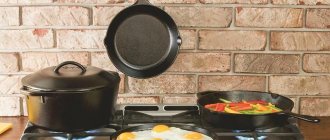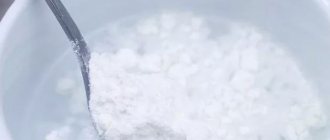So, something that had been planned for a long time happened - after a long search and selection, a cast iron cauldron was purchased. This is a real event, because every housewife knows that without a real cauldron there will be no real pilaf and many other favorite dishes. But buying a real cast iron cauldron is half the battle. In order for the food in it to be cooked as it should be and have a unique taste and aroma, the first thing you need to know is how to properly fire a cast iron cauldron. In general, a cauldron is a magical “pot” that necessarily requires knowledge of how to prepare a cauldron for its first use. And if everything is done correctly, the cauldron will give you a long term of impeccable service and delicious dishes.
What you need to know first
Unpleasant smoke, smell and taste in the cauldron is formed if the preparation of the cauldron for the first use was not carried out or something was done wrong. All foreign odors when working with a cauldron appear due to the fact that this type of kitchen equipment is generously coated with machine oil during manufacture. Or rather, it is not the cauldron itself that is lubricated, but the mold in which it is cast. This is done so that the future cauldron does not stick to the mold. Therefore, there is no way to do without primary processing after purchase. It is absolutely necessary to ensure that all remaining oil is removed. After which the cauldron must be heated, otherwise, at the end of cooking, its surface will be covered with rust, and the food will burn.
Why do they do it?
A new cauldron is prepared for first use by calcination. This procedure is mandatory.
Firing is carried out due to the fact that machine oil is used in the production process of dishes. To make the product come out of the mold easier, it is filled with a technical agent.
Oil also protects cast iron from the formation of rust, because products are not immediately sold out, many of them sit in the back room for years before they fall into the hands of the owner.
Such grease is also harmful to health and will make food inedible. Therefore, it is imperative to fire the cauldron. There is no need to rush to prepare dishes. You risk spoiling the pilaf and getting poisoned by machine oil.
A new cast iron cauldron must be properly prepared for its first use.
Removing machine oil from the surface of the product will take a lot of time. Manufacturers and experienced housewives recommend calcining in the fresh air.
During firing there will be a lot of smoke and unpleasant aromas. Therefore, it is necessary to open all the windows in the kitchen wide, turn on the hood and close the doors to other rooms.
If you have a country house or dacha, it is possible to carry out firing in the fresh air, feel free to take cast iron cookware and go there.
Preparing a new cast iron cauldron for work
So, the preparation of the cast iron cauldron for the first use begins. To do this you will need some available tools:
- a simple kitchen sponge for washing dishes;
- refined vegetable oil;
- packaging of rock salt;
- laundry soap;
- roll of kitchen towels.
How to prepare a new cast iron cauldron for use
Stage 1 - How to prepare a cast iron cauldron for use using salt
- Pour the entire pack of rock salt into the new container. Distribute it evenly over the bottom.
- Turn on the stove at maximum power.
- Be sure to turn on the hood. Open the windows. Ideally, open the doors. A draft will be a good helper in this process.
- The new cauldron will be heated for 30 minutes. The salt should be stirred regularly with a metal spatula.
- After some time, the salt will begin to change color to gray. This suggests that everything is going according to plan and the salt absorbs factory grease and other third-party impurities well.
- After the specified time has passed, the salt must be poured out. Cool the cauldron.
- When the new dishes have cooled down, wash them with laundry soap and hot water. Dry completely.
Stage 2 - Processing with oil: how to heat a cast iron cauldron at home
- When the dish has cooled, pour vegetable oil into it (300-700 ml, depending on the size of the dish).
- Set the stove to moderate heat, place a bowl of oil, and ignite it for half an hour. During the calcination process, the dishes need to be rotated from side to side so that the oil covers not only the bottom, but also the walls. This must be done very carefully so that the oil does not get on your hands. Never use oven mitts. An ordinary potholder. If something happens, you can immediately let go of it and throw it away, but the mitten, if oil gets on it, cannot be removed immediately. The result may be a severe burn. Once again, be very careful.
- After half an hour, the oil is drained. The dishes are cooled, washed and dried. Now you can start using the new miracle - inventory.
How to prepare a cast iron cauldron for the first use using the oven
When you buy a new cauldron, you need to know how to prepare it for the first use in different ways. One method was presented above. The preparation method using the oven is discussed here.
- Windows and doors, the hood, need to be prepared in the same way as mentioned above - arrange a draft.
- The oven must be accelerated to 180. Place a well-washed and dried cauldron in it.
- After some time, a bluish haze will appear. This is not scary - the factory lubricant burns.
- When the smoke stops coming out, turn off the oven and cool the cauldron. Rinse it with lukewarm water. Don't wash it cold. Cast iron is a fragile and sensitive material. He can't stand sudden changes.
- Next, calcination begins with salt or oil - your choice. After calcination is completed, intensive washing with detergent follows. To make the cauldron dry faster, you can place it on a low flame on the stove.
Types of calcination
Firing a cast iron cauldron before the first cooking is simply necessary; there are several types of calcination; you can choose the most suitable one and prepare your kitchen utensils.
Calcination with table salt
Salt is poured onto the bottom of the vessel and placed on a hot stove or fire. The seasoning will absorb all the excess liquid and remaining oil, after which the cauldron will become completely suitable for preparing food. Together with salt, the utensils will smoke and smell less; immediately after they darken, turn off the stove and allow the cast iron to cool.
The seasoning will absorb all the excess liquid and remaining oil.
Oil treatment
After the standard calcination procedure, it is important to go through it again, but using oil. To do this, pour oil into the pan; if it is still hot, then use a potholder or a thick towel. Turn the cauldron so that all the walls are covered with oil, then place the container back on the open fire for ten minutes and wait until bluish smoke appears. To better lubricate the walls, take an ordinary long wooden spatula, which is wrapped in paper, and use it to distribute the oil along the walls of the kitchen utensil. This way it will penetrate into all the pores of the heated vessel and form a thin protective coating on the surface. Thanks to it, food will not burn to the bottom of the cauldron. After this procedure, all remaining contents are drained and the bottom of the container is wiped with a paper napkin.
Processing a cauldron in the oven
For this method, the oven is thoroughly heated to 180-200 degrees, the cauldron is washed with warm water without soap. Then place the dishes on a baking sheet and wait until dark smoke comes out of the cabinet doors. Allow the kitchen utensils to cool and wash with warm water, then dry with a towel.
Roasting over an open fire
Another method of effectively firing cast iron is firing over a fire. They hang the cauldron over the fire and wait until all the rusty spots disappear and the acrid gray smoke stops pouring out of the equipment. Kitchen utensils will begin to change color and become suitable for cooking.
How to form a non-stick coating
Preparation for first use involves not only eliminating machine oil odors and other impurities. In order for new cookware to function smoothly, it is imperative to make a non-stick coating.
This is done like this:
- The cauldron must be dry. Lubricate it generously with vegetable oil, without skimping.
- Place the coated dishes on paper towels. Use another towel or napkins to remove oil stains.
- Briefly turn the container upside down so that the oil drains. Then move it to the oven, accelerated to a temperature of 180. It is recommended to lay foil on the bottom of the oven so that the dripping oil does not fall on the oven cover.
- Keep the dishes in the oven for at least three hours. This time is needed for the oil to fry and turn into a thin but durable film that will protect the cauldron from burning.
Open fire
Every owner of such utensils should know how to properly fire a cauldron. Sooner or later this information will come in handy, especially when purchasing a new product.
The procedure can also be carried out on the street. This is a simple and good method, especially if there are small children in the house and you don’t want the baby to breathe in harmful odors.
In newspapers you can find advertisements with similar content: “I will fire a cast iron cauldron quickly and cheaply. I’ll get him ready for work.” Of course it is much more convenient, but is it of better quality?
It is better to prepare the product yourself. This way you know exactly how well the calcination was carried out.
How to fire a new cauldron outdoors:
- How to prepare for the procedure: before this, the product must be washed with laundry soap and wiped dry.
- Place the cauldron on the grill, oven or fire. You don't need to put anything in it.
- As in the case of an oven, a bluish smoke will begin to come from the product. This means that the factory lubricant has started to burn out.
- Burning is continued until the smoking stops.
- Then you need to put on gloves and remove the cookware from the heat. You cannot fill the grill or fire with water; it may get into the cauldron, which will lead to its damage. You can use sand or cover the fire with soil.
- After cooling, the cast iron cookware must be wiped with a cloth soaked in oil. This way you can remove soot. Also, with a napkin soaked in oil, you need to wipe the internal surfaces of the cookware, this creates a non-stick coating.
- The cauldron is put back on the fire and heated until smoke appears. A thin film should form on the wall of the product. To avoid drips, go over the dishes with a brush, distributing the oil evenly over the entire surface.
Outdoors, you can heat the cauldron using vegetable oil and table salt. The algorithm of actions is the same.
The entire procedure will take from two to four hours. The time depends on the volume of the surface being fired. It is important that all the engine oil burns out. Gradually, as it burns, the inner walls of the cauldron become clean and shiny.
After all procedures are completed, the cast iron cookware is wiped with a cloth.
What to do when you buy an aluminum cauldron
With a cast iron cauldron everything is completely clear. It remains to talk about how to prepare an aluminum cauldron for the first use. By and large, the preparation process is not very different from the preparation of cast iron cookware. But there is still a very important nuance. Aluminum can withstand high temperatures much worse than cast iron. It is because of this that calcination and other stages of preparation must be carried out at medium temperature. Processing is carried out with fire and oil.
Now, knowing how to properly fire a cast iron cauldron and how to prepare an aluminum cauldron for use, you can be sure that the cookware will serve faithfully for a long time and with benefit. The main thing is to follow all the above rules.
Oil treatment
The value of cast iron cookware is that homemade methods can create a non-stick coating, as well as the ability to remove damage and rust.
But to avoid this, it is better to prepare a new cast iron cauldron for use immediately after purchase and prevent corrosion.
Over time, of course, spots of rust will appear on the product. Cast iron is porous and the coating is not airtight, but oil treatment will save you from red spots, and will also remove the remnants of technical means used in the production process.
This method will fill the porous structure of the product with film. This is a kind of protection against burnt food and rust.
How to heat an aluminum cauldron and a cast iron one:
- Any oil is poured into the bottom of the product. Manufacturers recommend using sesame, sunflower or flaxseed. But in this procedure you can also use lard or chicken fat. Lubricate all surfaces of the dishes with oil. It is not necessary to use fresh product. You can use old oil that has already expired. It is suitable for processing cast iron cookware, but you should not add expired seasonings and oils to food.
- The cauldron is placed on the fire and after heating, the walls are carefully watered using a slotted spoon. The procedure will take about 20 minutes, all this time you need to stand near the stove and pour hot oil over the surfaces of the dishes. Oil will penetrate into the pores and fill them. As a result, the internal surfaces will become shiny and smooth.
Thanks to the oil, a non-stick coating is created and residues of the technical product are removed.
For a cauldron, this is the best way to prevent food from sticking during cooking.
How to prepare a Cossack for the first use at home
Step 5. Take our branded brush and clean off the tops. They've warmed up enough. To understand why you can’t work without gloves, and a rag is not suitable for cleaning here... The temperature of the cauldron is so high that the twine begins to burn.
Under no circumstances should you cool a cauldron with water or pour oil into a hot one. In the first case, it will burst due to temperature changes, in the second case, the oil will flare up and you can burn!
We continue to play on each ear...
Processing the cauldron after calcination
However, calcination is not enough. If you start cooking food in such a container, it will begin to stick to the walls of the cauldron. Therefore, before the first use, the cauldron must be treated with oil. It can be sunflower, flaxseed, sesame oil, or even just cooking oil.
The procedure looks like this:
- Pour enough oil into the cauldron. In this case, you need to ensure that no leaks form on the outside.
- When the oil is hot, use a slotted spoon or a tablespoon to carefully pour it over the sides of the cauldron. The procedure takes 15 – 20 minutes. If you do this longer, the oil will evaporate from the surface of the cauldron.
- After this, the cauldron is allowed to cool, excess oil is poured out, and the dishes themselves are wiped with paper.
Thus, a thin oil layer forms on the surface of the cast iron, which is absorbed into the metal, and thanks to this, during cooking, food will not stick to the bottom and walls of the cookware.
To properly calcinate a cast iron cauldron, no special devices or tools are required. You must carefully follow the instructions and observe safety precautions.
Preventing carbon deposits
Real, high-quality cast iron cauldrons and kettles are easy to use, and food usually does not burn in them. However, before the first use, new dishes should be properly prepared so that they can be easily washed.
Wash your purchase using dish soap or regular soap (particles of technical oil and other contaminants may remain on the metal) and dry thoroughly. Take a soft cloth, soak it in refined vegetable oil and wipe the dishes inside and out. Remove excess with a paper towel, wiping it over the entire surface.
Then the cauldron needs to be properly calcined. Turn on the oven and place the pot in it upside down. You should not preheat the oven in advance - the temperature should increase little by little, gradually heating the metal to +200 ℃. After heat treatment for an hour, the oil will fill the pores of the cast iron and form a protective layer on the surface. As a result, the dishes will absorb less soot and dirt, and the food will not burn.
A new pot can be baked in the oven several times.
Cleaning a cauldron from carbon deposits at home is not difficult if you know simple secrets
After processing a cast iron product, it is important to restore the fat film so that cooking continues to be a pleasure.
Rules for firing a cauldron before first cooking
Food casting is fired so that the factory lubricant burns out. It turns into smoke and soot, which is removed with hot water and soap. The procedure for firing a cast-iron cauldron before the first cooking is lengthy and unpleasant: a fair amount of smoke is generated, and it does not smell like roses. Aluminum is processed faster; when working with it, several nuances must be taken into account. There are features of firing a cauldron.
The food turns out much tastier and more aromatic, since such dishes are cleaned of technical grease and undergo a procedure for renewing the protective coating with oil.
Note! Some manufacturers produce cauldrons with a black non-stick coating. This is a thin layer of durable enamel
It is not oily to the touch; when wiping new dishes, no stains remain on the napkin. If you pour water, rainbow stains will not appear on it.
Cast iron
Cast iron products are very heavy. Casting is done with thick walls, thanks to which the products simmer rather than boil or fry. Cast iron must be handled with care. If accidentally dropped, the metal may crack; the alloy is classified as brittle. Below is detailed instructions on how to fire a new cast iron cauldron over a fire and at home, what you will need for this.
Without proper processing, food cooked in a cauldron will simply be inedible and smell bad, and cooking in general will become impossible.
Aluminum
Aluminum alloy, or rather duralumin for casting, is valued for its low specific gravity. But the metal has one peculiarity: when unevenly heated, internal stresses form in it; the cauldron can become deformed if fired over high heat.
If you want to maintain the roundness of the walls and the evenness of the bottom, the metal should be heated slowly, gradually.
By the way, the thermal conductivity of aluminum is higher than that of cast iron. Food in an aluminum cauldron cools down faster and is not as flavorful.
Aluminum casting is often chosen by those who enjoy active recreation and cook in nature.
Where can you heat a cauldron?
You can heat the cauldron at home or outside. It is important to know certain subtleties of each method.
Calcination at the stake
To make it convenient to heat the cauldron, before lighting the fire, take care of how the container will be located above the fire. You can use a tripod or build walls out of bricks where you can place the dishes.
Calcination on the grill
The grill is convenient because it does not require the construction of additional devices to hold the cauldron. After lighting the fire, place the container on the walls of the grill. Do not forget to maintain the desired level of fire during the firing process.
Calcination on the stove
Regardless of whether you are going to heat the cauldron on a gas or electric stove, take precautions. Be sure to provide a flow of fresh air into the room, otherwise you will be poisoned by toxic fumes from factory oils. The processing schemes for both electric and gas stoves are identical.
Care
Calcination is necessary not only for new products. This procedure must be carried out if, after cooking, there are pieces of burnt food left on the bottom and walls.
If you can’t do without detergents and still have to wash the product with an aggressive agent, you need to burn it and build up the oil layer again.
A new cauldron requires the attention of the hostess. It requires preliminary preparation before using it in the kitchen.











